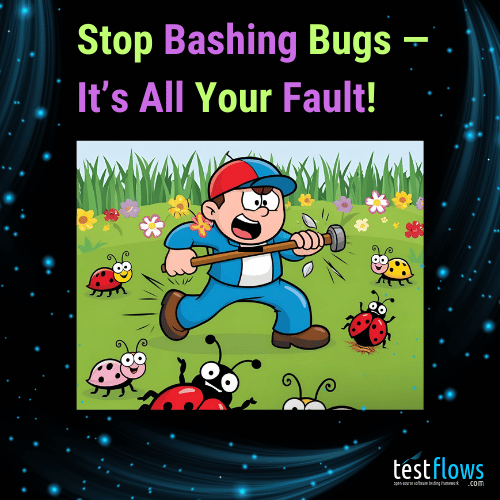You’re running your tests, and there it is again — a red light, a failing check, you’ve found another bug. You sigh, roll your eyes, and maybe if you are a tester you mutter something about “the devs” or if you are a dev, well there is nobody to blame but yourself. But what if I told you… the bug isn’t the problem?
In fact, that little bug might be your system’s most honest state. And the truth is, it’s not the bug’s fault that you don’t want it — it’s yours!
Inspired by the first BugBash 2025 software reliability conference organized by Antithesis, this post is a lighthearted, and (hopefully) helpful take on why bugs deserve a little more love — or at least, a little less blame.
The universe of software states
Every software system — no matter how simple or complex — can be described as a collection (set) of possible states. A state is just a snapshot of your system at a given moment.
More precisely,
A state is defined as an assignment of values to variables and this means that any state is defined by its variables and the values that those variables can have.
Also, to make our life interesting,
No matter what you think the state variables are for a given problem, you can always add more. In fact, there are infinitely many variables you could list to represent any given state.
Here’s the kicker: the system doesn’t “know” which states are good or bad. It just is. The universe allows every combination of all possible values for each variable in the state of your system, and it’s up to you, the designer, to say which ones are valid, desirable, and expected.
Let’s take a ridiculously simple example, the function to add two numbers:
1 | def add(a, b): |
Now imagine these two states:
- One of the desirable states
✅
- The unwanted state
❌
Both are perfectly valid from the universe’s perspective — but only one matches our definition of what addition means. The second state is a “bug” only because we decided that 1 + 1 must equal 2.
And that’s the whole point. A “bug” is just an undesirable state. It’s not evil. It’s not malicious. It’s just a possibility.
“Bug or feature?” – Perspective matters
Every tester or developer has faced the eternal question:
“Is this a bug… or a feature?”
And the truth is, the difference often lies in perspective.
Sometimes, a “bug” gets discovered and users actually like it. Or your team realizes that the “unexpected” behavior solves a real-world problem — and suddenly it’s promoted to “undocumented feature” status. That’s because there’s nothing inherently wrong with a bug state. It’s just not aligned with someone’s expectations — which may themselves be shifting or incomplete. In other words, bugs are just states we didn’t plan for — and sometimes, not planning for something is the real bug.
Why bugs happen: the problem of state explosion
As systems grow in complexity, the number of possible states grows exponentially. This is the well-known problem of state explosion. You may only think in terms of a few inputs or edge cases, but your system doesn’t care — there always could be more values for inputs or more inputs than you expected. Since we can’t test every possible state, undesirable ones sneak in — and surprise! They often get labeled as bugs.
But the truth is, the system is just exploring the space you built for it. You gave it the keys, and it took a wrong turn… because you forgot to build a roadblock.
What can we do? — Design with state space in mind
We can’t eliminate bugs entirely, but we can improve how we deal with them — and even reduce how often they show up — by designing with possible state space in mind.
✅ Tip #1: Limit the state space
Be ruthless. Avoid adding options, flags, or configurations unless they’re truly needed. Every additional branch or case increases the number of possible states exponentially.
✅ Tip #2: Define what “valid” means
Don’t just rely on intuition. If you can, formally define the valid state space. Whether it’s contracts, assertions, or state models — write it down.
✅ Tip #3: Test behaviors, not just results
Focus on how the system behaves in response to events and inputs over time. A snapshot might pass, but the path to get to it could still be wrong.
✅ Tip #4: Use model-based or property-based testing
These testing approaches are great at exploring unexpected states and helping you find issues in places your brain forgot to look.
✅ Tip #5: Treat bugs as insights
Every bug is a clue about your system’s structure. Ask: “What path led here?” and “How can we prevent it — or learn from it?”
A new attitude towards bugs
So let’s stop bashing bugs. Let’s stop treating them like invaders or villains. Bugs are natural consequences of systems we build. They’re not lies — they’re inconvenient truths. A bug is your system telling you, “Hey, I can do this too — did you think about that?” Instead of blame, let’s bring curiosity. Instead of punishment, let’s pursue understanding. And instead of fear, let’s aim for better design.
Conclusion: Embrace your bugs
Next time you find a bug, don’t reach for your hammer — reach for your model.
Try asking:
“What state did I forget to consider?”
“Is this really a mistake, or just a path I didn’t anticipate?”
“What can I learn from this bug?”
And remember — bugs don’t happen to you. They happen because of you. And that means… you’re in control!
Bonus: Explore behaviors with TestFlows
If you’re interested in testing using behavior models or exploring equivalence classes, check out TestFlows and other articles on this blog such as Combinatorial Testing: Writing Behavior Model. TestFlows is a Python testing library designed to help you write better tests, define, and explore complex systems in a structured way including behavior models (extension of property-based testing) — so you can prevent bugs by understanding your system better. With TestFlows, you’ll write test programs instead of just tests and the sky will be the limit of what testing you can do to find the undesirable states — the bugs.


















